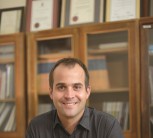In the first study of its kind, researchers at the University of Pretoria (UP) have made headway in understanding the accuracy and reliability of sound-level monitoring earphones and the effect of smartphone feedback, as an intervention to encourage safe listening use among young people.
This innovative research could change the lives of millions of people by reducing the risk of hearing loss caused by personal audio systems. “This is an applied solution to the real-world problem of hearing loss for more than a billion young people at risk,” says Professor De Wet Swanepoel of UP’s Department of Speech-Language Pathology and Audiology, who led the study. The study was published in the peer-reviewed journal Ear and Hearing.
“This world-first technology includes high-quality earphones, with an in-ear microphone to measure personal sound exposure in a person’s ear canal,” explains Prof Swanepoel. “Coupled with a tracking app that provides real-time feedback on sound levels when using the personal audio devices, dbTrack provides a first-of-its-kind solution for safe listening.”
More than a billion adolescents and young people are estimated to be at risk of acquiring recreational noise-induced hearing loss (RNIHL) because of the unsafe use of personal audio systems. RNIHL is preventable, and this research offers an important intervention to promote healthy listening behaviour.
Prof Swanepoel says once the delicate inner ear hair cells are damaged, the hearing loss is permanent and irreversible. Loud noise is particularly harmful to the inner ear. One-time exposure to extremely loud sound or listening to loud sounds for a long time can cause hearing loss.
He adds that the accompanying dbTrack smartphone application records listening activity measured by the earphones and calculates an accurate sound exposure dose in real-time. “Described as a Fitbit for your ears, the dbTrack earphones and app provide instant feedback based on personal listening behaviours,” says Prof Swanepoel.
“The in-ear microphone inside the earphone measures sound levels in real-time as the music is playing in someone’s ear through their personal audio device. Each set of earphones are individually calibrated for accuracy.”
The research team had two objectives. “Firstly, we needed to determine how accurate the in-ear sound-monitoring feature was compared to laboratory equipment,” explains Prof Swanepoel. “We recorded sound intensity levels over time in the ears of participants, then recorded the same intensity levels in standard laboratory equipment. We also did test-retest checks in both conditions. Results demonstrated that the in-ear monitoring feature was very accurate and reliable within 1dB.
“Secondly, we wanted to evaluate whether the dbTrack technology and app-based feedback changed listening behaviours when used by listeners. We enrolled participants who were regular users of personal audio devices. They received the dbTrack earphones and app. The research app was set to show no monitoring feedback for the first two weeks of the study as a control condition. After two weeks, the app switched to provide feedback and notifications on their sound exposure. Results demonstrated significantly safer levels and durations of listening when the app feedback was active.”
The app includes feedback on the intensity, duration and associated risk of hearing damage for individuals. The criteria are based on the WHO and ITU Safe Listening Standards.
Prof Swanpoel offers the following tips to protect your ears:
The first manufacturer to include this technology was Westone audio, in partnership with the hearX Group, and the first production run is already sold out. New versions with various manufacturers of earphones are planned for future release. This study was the proof of concept validating this innovative technology for widespread use.
Prof De Wet Swanepoel
April 28, 2021

Professor De Wet Swanepoel, PhD, is a professor of audiology in the Department of Speech-Language Pathology and Audiology in the Faculty of Humanities at the University of Pretoria (UP). He is a leading international researcher in teleaudiology, hearing health innovation and new service delivery models.
Prof Swanepoel is Research Director of the World Health Organisation’s (WHO) Collaborating Centre for Prevention of Deafness and Hearing Loss at UP. He is also a senior research fellow at the Ear Science Institute Australia, and has served as a visiting professor at universities in the US, Sweden and Australia.
His research capitalises on digital health to explore, develop and evaluate innovative technologies and service delivery models for ear and hearing care. He has published more than 220 peer-reviewed articles, books and book chapters, and is funded by the US National Institutes of Health, the Academy of Medical Sciences in the UK, the National Research Foundation, SA, and other industry partners. He has received numerous international awards for his work, from international science councils, audiology associations and industry.
Prof Swanepoel is a sought-after keynote speaker at international events for global organisations such as the WHO, and for American and British academies of audiology. He regularly features on national and international TV and radio channels, including CNN, Sky News, CNBC and the BBC. Prof Swanepoel is also Editor-in-Chief of the International Journal of Audiology and a former president of the International Society of Audiology. He holds several patents and is founder of hearX group, a digital health company.
 Story
Story
In a study that signals potential reproductive and health complications in humans, now and for future generations, researchers at the University of Pretoria and Canada’s McGill University and Université Laval have concluded that toxins in the environment, notably DDT, modify the sperm epigenome at sites potentially transmitted to the embryo at conception.
 Story
Story
Scientists at the University of Pretoria (UP) are leading a study of natural hydrogen gas discovered under the Earth’s surface in Mpumalanga – a source of renewable energy that could contribute to the national energy budget and help address the energy shortage in South Africa.
 Infographic
Infographic
Hydrogen is considered a fuel of the future due to it emitting zero emissions. This infographic explains the impact of this discovery as well as some interesting facts about hydrogen and the different forms of it.
Copyright © University of Pretoria 2024. All rights reserved.
Get Social With Us
Download the UP Mobile App